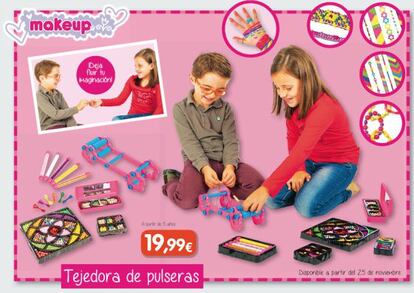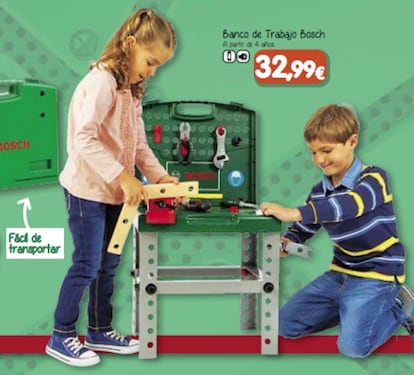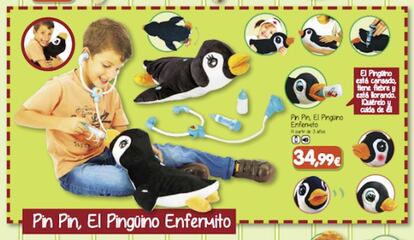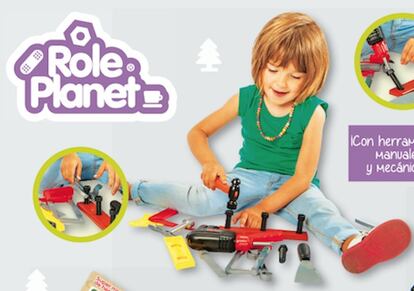The success of a Spanish toy company’s non-sexist catalogue
Toy Planet revisits last year’s initiative showing girls with tools and boys pushing strollers


For the second year in a row, Toy Planet has published a Christmas catalogue that deliberately tries to avoid casting boys and girls in gender-specific roles.
Instead, the Spanish toy chain shows little boys playing with dolls and pushing tiny baby strollers, and little girls riding motorcycles and handling toy DIY kits.

The initiative began three years ago with pictures posted on the company’s Facebook and Twitter accounts, explains Toy Planet general director Ignacio Gaspar. The response was so positive that executives decided to put the idea down on paper in Toy Planet’s 2014 Christmas catalogue.
“We were hoping that other [stores] would join our initiative, but so far we’re not seeing that happen,” he says.
In fact, the most they’ve seen is a picture of a little boy playing with a toy iron in the catalogue of El Corte Inglés, Spain’s leading department store.
“This is still an unresolved matter in the industry. We would like to see more companies joining us,” says Gaspar, who plans to keep publishing non-sexist toy catalogues next year.
But the gender-neutral photographs only involve the chain’s own toys, marketed under the Toy Planet brand. Other makers have so far been reticent about changing their own campaigns.

“They’ve congratulated us a lot, but the support has been more about attitude than about behavior,” says Gaspar, who has noticed a little bit of change in recent years, albeit slowly.
“It’s still hard going. If communication is not encouraged, it’s hard for someone to take the helm with the changes,” he notes. “Who does it? The families? The companies? It’s like a dog chasing its tail.”
But some change is visible. Play kitchens, for instance, are now a unisex product for many makers, given that these days many fathers cook in the home and that more and more boys are asking for these toys. The same goes for construction toys, with which a growing number of girls are playing.

Some studies also show that girls are increasingly interested in superheroes, which until recently had been considered an all-male territory. And thanks to advocacy work by groups such as Let Toys Be Toys, a growing list of British toy stores and retailers are dropping the “girls” and “boys” signage on their toy aisles.
The latest chain to join the club was the giant US discount retailer Target. As The Washington Post noted, this measure “simply means organizing products children already love according to interest or theme — not by boy or girl.”

In fact, The New York Times points out that “toys are more strictly gendered today than they were 50 years ago, when adult gender roles were much more separate, according to research by Elizabeth Sweet, a sociologist at the University of California, Davis.”
According to that study, a 1975 Sears catalogue showed that only two percent of toys were labeled as being specifically for boys or for girls, while in 2012, all the products at the Disney store were gender-specific.
About Verne
Something similar has happened with the use of pink and blue colors. Until World War I, white was used for both genders, and originally pink was preferred for boys while blue was seen as more feminine, notes the historian Jo B. Paoletti in Pink and Blue: Telling the Girls from the Boys in America. Pink began co-opting girls’ products in the 1980s, when gender differentiation by color became much more widespread.
There is a precedent for Toy Planet’s initiative: three years ago, Top Toys, a Toys ‘R’ Us franchise in northern Europe, published a catalogue for the Swedish market that also turned gender roles on their head, with boys combing dolls’ hair and girls wielding dart guns.
English version by Susana Urra.
Tu suscripción se está usando en otro dispositivo
¿Quieres añadir otro usuario a tu suscripción?
Si continúas leyendo en este dispositivo, no se podrá leer en el otro.
FlechaTu suscripción se está usando en otro dispositivo y solo puedes acceder a EL PAÍS desde un dispositivo a la vez.
Si quieres compartir tu cuenta, cambia tu suscripción a la modalidad Premium, así podrás añadir otro usuario. Cada uno accederá con su propia cuenta de email, lo que os permitirá personalizar vuestra experiencia en EL PAÍS.
¿Tienes una suscripción de empresa? Accede aquí para contratar más cuentas.
En el caso de no saber quién está usando tu cuenta, te recomendamos cambiar tu contraseña aquí.
Si decides continuar compartiendo tu cuenta, este mensaje se mostrará en tu dispositivo y en el de la otra persona que está usando tu cuenta de forma indefinida, afectando a tu experiencia de lectura. Puedes consultar aquí los términos y condiciones de la suscripción digital.
Archived In
Últimas noticias
The complicated life of Francesca Albanese: A rising figure in Italy but barred from every bank by Trump’s sanctions
How Japan is trying to avert ‘digital defeat’
Half of Scotland is in the hands of 420 property owners
Reinhard Genzel, Nobel laureate in physics: ‘One-minute videos will never give you the truth’
Most viewed
- Pablo Escobar’s hippos: A serious environmental problem, 40 years on
- Why we lost the habit of sleeping in two segments and how that changed our sense of time
- Charles Dubouloz, mountaineering star, retires at 36 with a farewell tour inspired by Walter Bonatti
- Reinhard Genzel, Nobel laureate in physics: ‘One-minute videos will never give you the truth’
- The Florida Keys tourist paradise is besieged by immigration agents: ‘We’ve never seen anything like this’








































